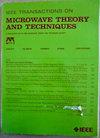用于介质波导模式分析的空场法-表面等效原理方法
IF 4.1
1区 工程技术
Q2 ENGINEERING, ELECTRICAL & ELECTRONIC
IEEE Transactions on Microwave Theory and Techniques
Pub Date : 2024-09-18
DOI:10.1109/TMTT.2024.3449277
引用次数: 0
摘要
本文章由计算机程序翻译,如有差异,请以英文原文为准。
A Null Field Method-Surface Equivalence Principle Approach for Mode Analysis of Dielectric Waveguides
In a recent paper, the method of auxiliary sources (MAS) with two excitation sources (MAS-TES) was developed to compute the propagation constants of cylindrical dielectric waveguides. It was demonstrated that to ensure MAS-TES remains free from spurious solutions, both excitation sources must lie within the domain defined by an optimum curve. The null field method, when combined with the surface equivalence principle (NFM-SEP), constitutes another surface integral-equation-based method (SIEBM). It differs from MAS in that it defines equivalent currents on the physical boundary while enforcing boundary conditions on auxiliary surfaces. In this work, we introduce and employ a discretized version of NFM-SEP employing two excitation sources (TES) to perform mode analysis of dielectric waveguides. This new method is termed NFM-SEP with two excitation sources (NFM-SEP-TES). In addition, we validate the efficacy of the current vector norm (CVN) approach within NFM-SEP-TES. All obtained numerical results demonstrate that NFM-SEP-TES is devoid of spurious solutions, unlike MAS-TES, under all conditions.
求助全文
通过发布文献求助,成功后即可免费获取论文全文。
去求助
来源期刊

IEEE Transactions on Microwave Theory and Techniques
工程技术-工程:电子与电气
CiteScore
8.60
自引率
18.60%
发文量
486
审稿时长
6 months
期刊介绍:
The IEEE Transactions on Microwave Theory and Techniques focuses on that part of engineering and theory associated with microwave/millimeter-wave components, devices, circuits, and systems involving the generation, modulation, demodulation, control, transmission, and detection of microwave signals. This includes scientific, technical, and industrial, activities. Microwave theory and techniques relates to electromagnetic waves usually in the frequency region between a few MHz and a THz; other spectral regions and wave types are included within the scope of the Society whenever basic microwave theory and techniques can yield useful results. Generally, this occurs in the theory of wave propagation in structures with dimensions comparable to a wavelength, and in the related techniques for analysis and design.
 求助内容:
求助内容: 应助结果提醒方式:
应助结果提醒方式:


